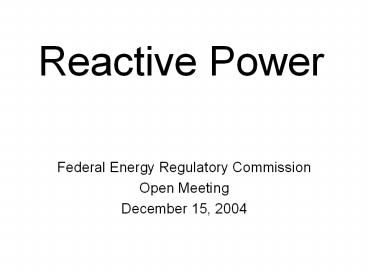AEP Methodology PowerPoint PPT Presentation
Title: AEP Methodology
1
Reactive Power
Federal Energy Regulatory Commission Open
Meeting December 15, 2004
2
Reactive Power Policy
- Review of Current Policy
- Blackout
- New Generation Filings
- Staff White Paper in Progress
- March 3, 2005 Technical Conference (tentative
date)
3
Reactive Power Sources Users
Sources Generators, Transmission Equipment
(Capacitors, Static Var Compensators) Users
Transmission Lines, Transformers, Loads (motors)
Photos courtesy of Areva Transmission
Distribution, Hitachi, and NREL
4
AEP Methodology
- Generator and its exciter
- Accessory electric equipment that supports the
operation of the generator exciter and - Remaining total production investment required to
provide real power and operate the exciter
Apply allocation factor to sort annual revenue
requirements of these components between real and
reactive power
5
AEPs Financial Impact
- Estimate of all Form 1 reactive power charges is
3.5 to 4.0 billion
6
Goal of Reactive Power Policy
- Promote Reliable and Efficient Infrastructure
Investment, Production, and Customer Use
7
Market Issues
- Comparable Treatment of Generation Resources
- Interconnection Standards
- Reactive Power Planning and Procurement
- Supply Incentives
- Demand Side Incentives
- Public Good
8
Reactive Power Capacity Options
- Cost of Service
- Forward Market Procurement
- Pay Nothing
9
Reactive Power Real-Time Options
- No Payment within Bandwidth, Opportunity Costs
Outside - Strict Opportunity Cost
- Market Clearing Prices
- Fixed Payment
10
Major Conclusions
- Align incentives with desired outcomes
- Pay for reactive power
- Apply comparability to reactive power
- Treat capability and production differently
- Pay more for dynamic than static capability
- Review AEP method
- Pay all sources same price for production
- Mitigate existing market power
- Entry may reduce future market power
PowerShow.com is a leading presentation sharing website. It has millions of presentations already uploaded and available with 1,000s more being uploaded by its users every day. Whatever your area of interest, here you’ll be able to find and view presentations you’ll love and possibly download. And, best of all, it is completely free and easy to use.
You might even have a presentation you’d like to share with others. If so, just upload it to PowerShow.com. We’ll convert it to an HTML5 slideshow that includes all the media types you’ve already added: audio, video, music, pictures, animations and transition effects. Then you can share it with your target audience as well as PowerShow.com’s millions of monthly visitors. And, again, it’s all free.
About the Developers
PowerShow.com is brought to you by CrystalGraphics, the award-winning developer and market-leading publisher of rich-media enhancement products for presentations. Our product offerings include millions of PowerPoint templates, diagrams, animated 3D characters and more.

